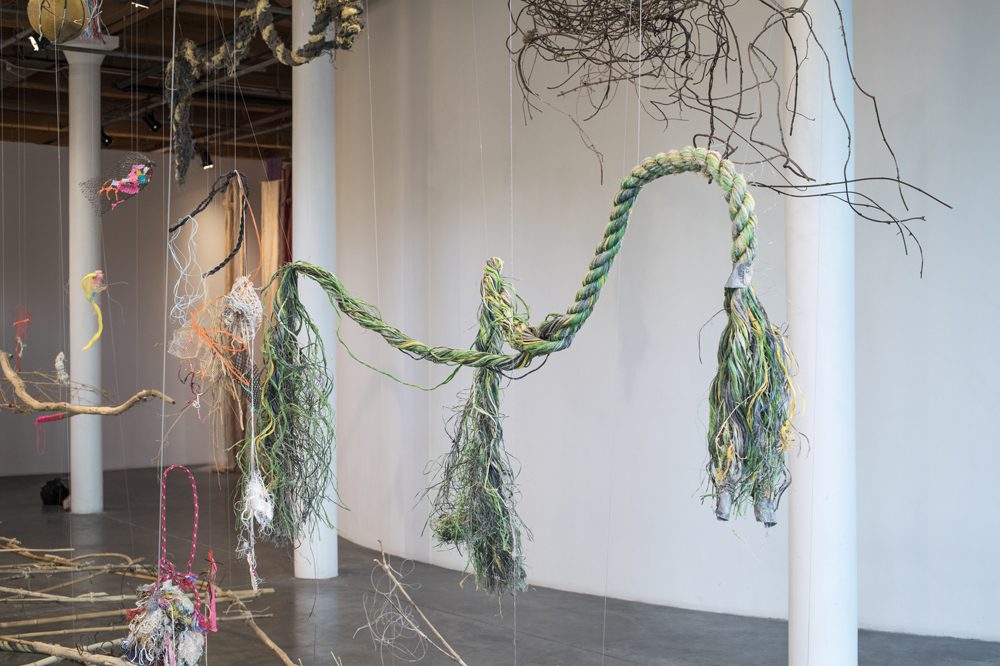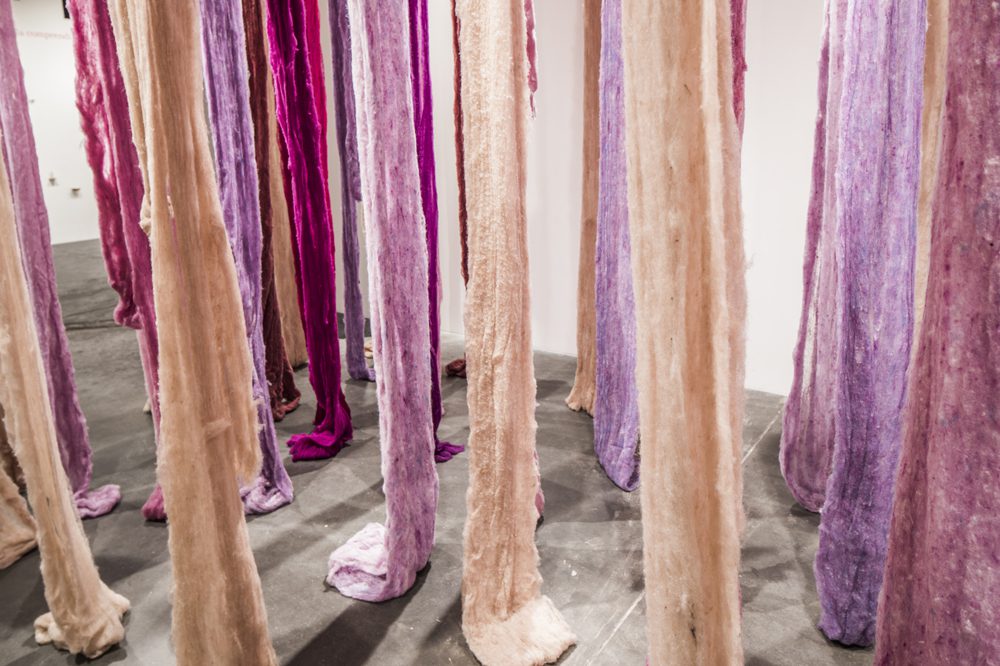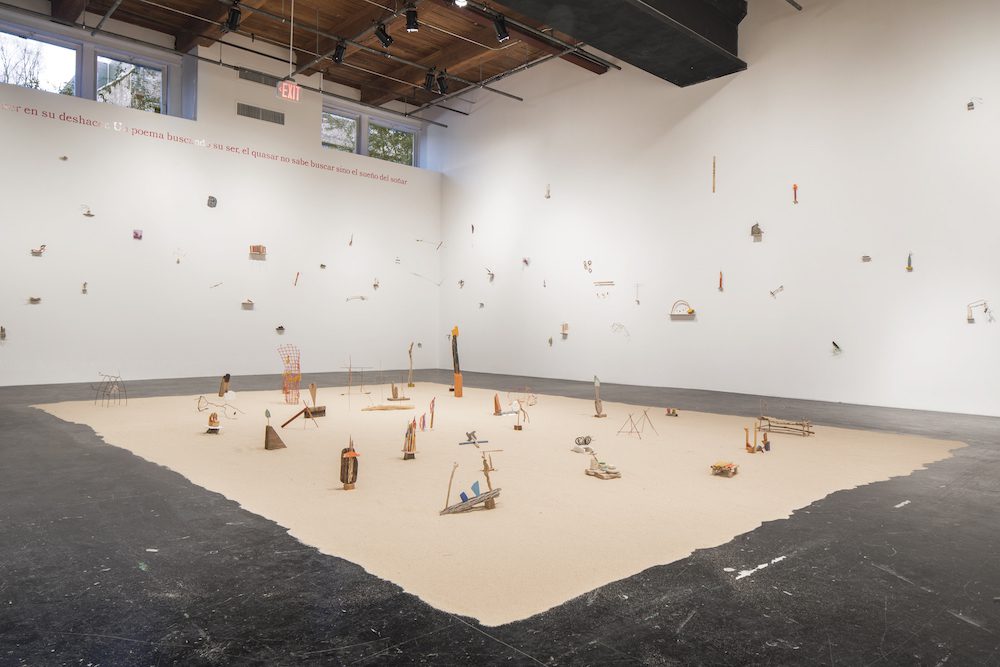An Un-Memorial to All That Has Been Lost: Cecilia Vicuña’s Precarious Assemblages
John Pluecker visits artist and poet Cecilia Vicuña’s first major solo exhibition in the United States at the Contemporary Arts Center.

Installation view of Cecilia Vicuña’s Balsa Snake Raft to Escape the Flood, 2017, at the Contemporary Arts Center, New Orleans. Found materials sourced from New Orleans, Chile, and New York. Courtesy the artist. Photo by Alex Marks Photography.
Let’s start with a close-up.
Grasses emerge out of the upper part of a piece of wood perched on two wooden pegs, stuck into the gallery’s white wall. All the elements appear to be found materials, even the pegs.
A little way to the right, six dried seed pods in a blue plastic mesh bag hang on the wall.
Further away, a weathervane-like structure of thin reeds is lodged in a bit of wood. It balances on a small wooden platform atop two of the same dowel-like pegs stuck in the wall.
Another nearby platform is home to a bamboo rod with a red string emerging from a crack in the side. The red string is taut, wrapped at its other end around a rock that it appears to pull.
When we step back from these small precarious assemblages, we see a larger wall, two walls, in fact sprinkled with these tiny sculptures. In the center of one gallery is a larger, but equally fragile assemblage of salvaged materials that hangs from the ceiling, an unseaworthy boat that houses a gentle promise to take us away. But to where? Might an assemblage of bits and pieces of refuse rescue us from the continuing crisis? From impending climate disaster?
Cecilia Vicuña’s exhibition “About to Happen” at the Contemporary Arts Center New Orleans is billed as the first major solo exhibition for the artist in the United States and features an array of media: performance, sculpture, drawing, video, text, and site-specific installation.
I’ve followed Vicuña’s work ever since first encountering it about ten years ago in poems on the Internet and on-line recordings and then in the books of poetry that she has since published, including Saborami (ChainLinks, 2011) and Spit Temple (Ugly Duckling Presse). When I found out about the show in New Orleans, about five hours away by car from my home in Houston, I knew I had to see it.

Installation view of Cecilia Vicuña’s Quipus Visceral, 2017, at the Contemporary Arts Center, New Orleans. Wool. Courtesy the artist. Photo by Alex Marks Photography.
Upon my first steps into the space, my gaze was lifted to behold the long strands of textile hanging from the ceiling: these quipus that Vicuña incorporates throughout her work. Quipus being an ancient Andean method for counting and for writing by means of threads and knots. Her work does not so much form a body as a web, an array of instantiations of a very particular worldview and a very particular investigative approach. She is consciously tracing out a return to the earth, to the body, and to indigenous lifeways with a series of gestural moves and delicate assemblages. The work is not so much anti-colonial or post-colonial, as it is an attempt at de-colonization through an ongoing process of thinking and re-thinking. There is nothing permanent in her work, rather we find a series of temporary amalgamations.
To see Vicuña’s work in this fraught moment is particularly profound. There are a million ways to delimit the boundaries of our current disaster; one would be to say that a self-serving and dangerous corporate brand has usurped the American presidency, with one result being that the U.S. has recently pulled out of the Paris Climate Accord. Especially being in New Orleans and below sea level, it was impossible for me not to see this exhibition in the context of these awful events and a worldwide ascension of nationalistic, anti-immigrant posturing. It’s difficult to create spaces of “hope” at this moment.
While “hope” seems quite far off right now, the exhibit did produce a physical effect. My body loosened. My muscles relaxed. My mind stopped with its stuttering half-thoughts and repetitive anxious cycling. My breath slowed. Something had happened. I felt like I had stepped inside one of Vicuña’s delicate poems, like my body had entered one of her oh-so-fragile congregations of words. And it made my body seem to hum, to murmur, to sing to itself.
Eventually I’d find myself laying down on the floor next to a wide expanse of sand with a friend: both of us so enraptured as to desire to lie down in the midst of it all. Maybe this is what a healing art might be made of, or if not healing, a series of gestures toward its possibility. Obviously, I’m being hyperbolic or a little overly romantic, but the space created by Vicuña’s work incites that kind of feeling. It welcomes feeling in a way I find contemporary art rarely seems to want to do.

Installation view of “Cecilia Vicuña: About to Happen” at the Contemporary Arts Center, New Orleans. Courtesy the artist. Photo by Alex Marks Photography.
Much of the exhibit is comprised of what Vicuña has named precarios, the precarious assemblages of wood and plastic and other found materials described at the beginning of this essay. I had first seen reproductions of these precarios and a description of them in Vicuña’s 1973 book Saborami (reprinted in 2011). Vicuña’s consistent and thorough investigation of the precarios as a form amazes me. Her constancy and her commitment to these small things means that they have accrued over the course of decades: not only the sculptural forms, but a host of (what I see as) precarios in other media: book arts, poems, drawings, smudges of words, textual art, cloth, sand.
The didactic text on the wall at the entrance to the exhibit mentions that Vicuña’s first experiments with precarios from the 1960s were not documented, evidence of what Vicuña calls “history as a fabric of inclusion and exclusion.” Vicuña asserts that this lack of documentation of the precarios means that they came to inhabit what she calls a “non-place” or “another reality.”
I’d argue that this non-space where the precarios end up living is the non-place where the vast majority of creative work lives: forgotten, brushed aside, re-purposed, recycled, un-remembered, un-catalogued, and utterly avoidable.
Despite this forgetfulness about the things people make, Vicuña treats her precarios with attention and care. They arch and curve, balance and alight, settle and sink. Her attention and care seem to change the space, to convert the space into an un-memorial to all that has been lost, is lost, and continues to be in a process of being lost. All of the small things swept aside by the great uncaring course of history.
One day I hope a museum will do a large-scale retrospective of Vicuña’s work, an exhibition that would weave together all the strands of her work over the last six decades since the 1960s to be able to show the force and breadth of her practice. Until then, this exhibition is a wonderful space to inhabit. I found it especially moving because of its thoughtfulness about making connections with the fragile and mistreated ecology of the Gulf Coast. The precarios were made out of materials salvaged from the New Orleans area and become reminders of the fragility of our Gulf ecosystem, but also they make a space to marvel at its resilience and its persistent fertility.
The expanse of sand that I laid beside in the middle of one gallery forms a sort of beach that is sprinkled with more of the precarios. Though these lands have been colonized and re-colonized, contaminated and industrialized by petrochemical industries, Vicuña seems to signal a way through all the madness of the Occident: a path of survival, a series of gestures that add up to something much larger than one person or one exhibition. A process of re-indigenization that just might be able to weave a future composed with what we already have at hand.
Editor's Note
“Cecilia Vicuña: About to Happen” was on view March 16–June 18, 2017 at the Contemporary Arts Center (900 Camp Street) in New Orleans.



